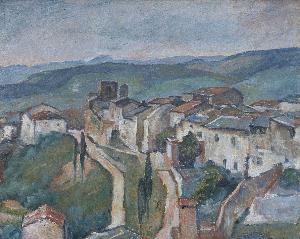Raffaele De Grada
Raffaele De Grada
Place: Milan
Born: 1885
Death: 1957
Biography:
Raffaele De Grada was an Italian painter born in Milan, Italy in 1885. He was initially trained by his father, a decorator, in Argentina and then from 1899 in Zürich. He attended the academies of Dresden and Karlsruhe over the period 1902-05. Influenced by the Swiss Secession movement, he enjoyed success as a landscape painter from 1913 on.
Early Life and Training
Raffaele De Grada's early life and training played a significant role in shaping his artistic style. He was born into a family of artists and was encouraged to pursue his passion for painting from a young age. His father, a decorator, provided him with initial training in Argentina and Zürich. Later, he attended the academies of Dresden and Karlsruhe, where he honed his skills as a landscape painter.
Artistic Career
De Grada's artistic career was marked by his association with the Swiss Secession movement. This movement, which emerged in the late 19th century, emphasized the importance of individualism and experimentation in art. De Grada's landscapes, characterized by their use of bold colors and emphasis on light and shadow, reflect the influence of this movement. Some of his notable works include Raffaele De Grada: Glarnealpen, which can be found on Wikioo.org.
Exhibitions and Associations
De Grada participated in numerous exhibitions throughout his career, including the Venice Biennale and the Novecento Italiano movement. He also associated with other notable artists of his time, such as Roger Eliot Fry and George Romney, whose works can be found on Wikioo.org and Wikioo.org, respectively.
Legacy
De Grada's legacy as a painter is characterized by his contribution to the Italian art scene in the early 20th century. His landscapes, which often depicted the Tuscan countryside, are notable for their use of bold colors and emphasis on light and shadow. De Grada's association with the Silvano Lodi Collection and the Museum of the Cathedral in Milan also reflect his importance as an artist.
- Influenced by the Swiss Secession movement, De Grada's landscapes are characterized by their use of bold colors and emphasis on light and shadow.
- De Grada participated in numerous exhibitions, including the Venice Biennale and the Novecento Italiano movement.
- His association with other notable artists, such as Roger Eliot Fry and George Romney, reflect his importance as an artist.
- De Grada's legacy is characterized by his contribution to the Italian art scene in the early 20th century.
De Grada's work can be found on Wikioo.org, which provides a comprehensive overview of his life and career as an artist. For more information about De Grada and other notable artists, visit Wikioo.org.


